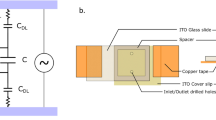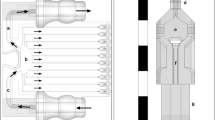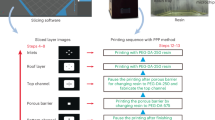Abstract
Microscale biopatterning enables regulation of cell–material interactions1,2 and cell shape3, and enables multiplexed high-throughput studies4,5,6,7,8 in a cell- and reagent-efficient manner. The majority of available techniques rely on physical contact of a stamp3, pin8, or mask9,10 with mainly a dry surface. Inkjet and piezoelectric printing11 is carried out in a non-contact manner but still requires a substantially dry substrate to ensure fidelity of printed patterns. These existing methods, therefore, are limited for patterning onto delicate surfaces of living cells because physical contact or substantially dry conditions are damaging to them. Microfluidic patterning with laminar streams12,13 does enable non-contact patterning in fully aqueous environments but with limited throughput and reagent diffusion across interfacial flows. Here, we describe a polymeric aqueous two-phase system that enables patterning nanolitres of a reagent-containing aqueous phase, in arbitrary shapes, within a second aqueous phase covering a cell monolayer. With the appropriate medium formulation, reagents of interest remain confined to the patterned phase without significant diffusion. The fully aqueous environment ensures high reagent activity and cell viability. The utility of this strategy is demonstrated with patterned delivery of genetic materials to mammalian cells for phenotypic screening of gene expression and gene silencing.
This is a preview of subscription content, access via your institution
Access options
Subscribe to this journal
Receive 12 print issues and online access
$259.00 per year
only $21.58 per issue
Buy this article
- Purchase on Springer Link
- Instant access to full article PDF
Prices may be subject to local taxes which are calculated during checkout




Similar content being viewed by others
References
Chen, C. S., Mrksich, M., Huang, S., Whitesides, G. M. & Ingber, D. E. Geometric control of cell life and death. Science 276, 1425–1428 (1997).
Khetani, S. R. & Bhatia, S. N. Microscale culture of human liver cells for drug development. Nature Biotech. 26, 120–126 (2008).
Singhvi, R. et al. Engineering cell shape and function. Science 264, 696–698 (1994).
Anderson, D. G., Levenberg, S. & Langer, R. Nanoliter-scale synthesis of arrayed biomaterials and application to human embryonic stem cells. Nature Biotech. 22, 863–866 (2004).
Anderson, D. G., Putnam, D., Lavik, E. B., Mahmood, T. A. & Langer, R. Biomaterial microarrays: Rapid, microscale screening of polymer-cell interaction. Biomaterials 26, 4892–4897 (2005).
Bailey, S. N., Sabatini, D. M. & Stockwell, B. R. Microarrays of small molecules embedded in biodegradable polymers for use in mammalian cell-based screens. Proc. Natl Acad. Sci. USA 101, 16144–16149 (2004).
Flaim, C. J., Chien, S. & Bhatia, S. N. An extracellular matrix microarray for probing cellular differentiation. Nature Methods 2, 119–125 (2005).
Ziauddin, J. & Sabatini, D. M. Microarrays of cells expressing defined cDNAs. Nature 411, 107–110 (2001).
Delamarche, E., Bernard, A., Schmid, H., Michel, B. & Biebuyck, H. Patterned delivery of immunoglobulins to surfaces using microfluidic networks. Science 276, 779–781 (1997).
Folch, A., Jo, B. H., Hurtado, O., Beebe, D. J. & Toner, M. Microfabricated elastomeric stencils for micropatterning cell cultures. J. Biomed. Mater. Res. 52, 346–353 (2000).
Roth, E. A. et al. Inkjet printing for high-throughput cell patterning. Biomaterials 25, 3707–3715 (2004).
Juncker, D., Schmid, H. & Delamarche, E. Multipurpose microfluidic probe. Nature Mater. 4, 622–628 (2005).
Takayama, S. et al. Subcellular positioning of small molecules. Nature 411, 1016 (2001).
Albertsson, P.-A. Partition of Cell Particles and Macromolecules 3rd edn (Wiley, 1986).
Eick, J. D., Good, R. J. & Neumann, A. W. Thermodynamics of contact angles. II. Rough solid surfaces. J. Colloid Interface Sci. 53, 235–238 (1975).
Stuart, J. M., Segal, E., Koller, D. & Kim, S. K. A gene-coexpression network for global discovery of conserved genetic modules. Science 302, 249–255 (2003).
Bailey, S. N., Ali, S. M., Carpenter, A. E., Higgins, C. O. & Sabatini, D. M. Microarrays of lentiviruses for gene function screens in immortalized and primary cells. Nature Methods 3, 117–122 (2006).
Hannon, G. J. RNA interference. Nature 418, 244–251 (2002).
Nelson, C. M. & Bissell, M. J. Of extracellular matrix, scaffolds, and signalling: Tissue architecture regulates development, homeostasis, and cancer. Ann. Rev. Cell Dev. Biol. 22, 287–309 (2006).
Streuli, C. H., Schmidhauser, C., Kobrin, M., Bissell, M. J. & Derynck, R. Extracellular matrix regulates expression of the TGF-beta 1 gene. J. Cell Biol. 120, 253–260 (1993).
Chen, S. S., Fitzgerald, W., Zimmerberg, J., Kleinmanc, H. K. & Margolis, L. Cell–cell and cell-extracellular matrix interactions regulate embryonic stem cell differentiation. Stem Cells 25, 553–561 (2008).
Liu, X. et al. A targeted mutation at the known collagenase cleavage site in mouse type I collagen impairs tissue remodeling. J. Cell Biol. 130, 227–237 (1995).
Chun, T. et al. A pericellular collagenase directs the 3-dimensional development of white adipose tissue. Cell 125, 577–591 (2006).
Sabeh, F. et al. Tumor cell traffic through the extracellular matrix is controlled by the membrane-anchored collagenase MT1-MMP. J. Cell Biol. 167, 769–781 (2004).
Hotary, K., Allen, E., Punturieri, A., Yana, I. & Weiss, S. J. Regulation of cell invasion and morphogenesis in a three-dimensional type I collagen matrix by membrane-type matrix metalloproteinases 1, 2, and 3. J. Cell Biol. 149, 1309–1323 (2000).
Li, X.-Y., Ota, I., Yana, I., Sabeh, F. & Weiss, S. J. Molecular dissection of the structural machinery underlying the tissue-invasive activity of membrane type-1 matrix metalloproteinase. Mol. Biol. Cell 19, 3221–3233 (2008).
Song, J. W. et al. Microfluidic endothelium for studying the intravascular adhesion of metastatic breast cancer cells. PLoS One 4, e5756 (2009).
Wang, L., Jackson, W. C., Steinbach, P. A. & Tsien, R. Y. Evolution of new nonantibody proteins via iterative somatic hypermutation. Proc. Natl Acad. Sci. USA 101, 16745–16749 (2004).
Ventura, A. et al. Cre-lox-regulated conditional RNA interference from transgenes. Proc. Natl Acad. Sci. USA 101, 10380–10385 (2004).
Smith, M. C. et al. CXCR4 regulates growth of both primary and metastatic breast cancer. Cancer Res. 64, 8604–8612 (2004).
Acknowledgements
The financial support for this research was provided by a gift from J. Passino and NIH grants P50CA093990 and R01CA136553. H.T. acknowledges a postdoctoral fellowship (NSERC PDF-329449-2006). We thank M. El-Sayed and Y.-L. Lin for spectrophotometry measurements.
Author information
Authors and Affiliations
Contributions
H.T. designed and carried out experiments, analysed the data and wrote the manuscript. A.J. helped optimize transfection experiments. B.M. helped with patterning experiments and imaging microarrays. Q.Y.L. carried out image processing of transfected cell microarrays. X.L. prepared collagen and helped with the collagen degradation assay. K.E.L. prepared lentiviruses. G.D.L. helped design viral transduction experiments and optimize them. S.J.W. helped design the collagen degradation assay. S.T. designed the project and edited the manuscript. All authors commented on the manuscript.
Corresponding author
Supplementary information
Supplementary Information
Supplementary Information (PDF 977 kb)
Supplementary Information
Supplementary Movie 1 (MOV 1612 kb)
Supplementary Information
Supplementary Movie 2 (MOV 1280 kb)
Rights and permissions
About this article
Cite this article
Tavana, H., Jovic, A., Mosadegh, B. et al. Nanolitre liquid patterning in aqueous environments for spatially defined reagent delivery to mammalian cells. Nature Mater 8, 736–741 (2009). https://doi.org/10.1038/nmat2515
Received:
Accepted:
Published:
Issue Date:
DOI: https://doi.org/10.1038/nmat2515
This article is cited by
-
Phase-separation facilitated one-step fabrication of multiscale heterogeneous two-aqueous-phase gel
Nature Communications (2023)
-
Continuous, autonomous subsurface cargo shuttling by nature-inspired meniscus-climbing systems
Nature Chemistry (2022)
-
Protocell arrays for simultaneous detection of diverse analytes
Nature Communications (2021)
-
Photosynthetic hydrogen production by droplet-based microbial micro-reactors under aerobic conditions
Nature Communications (2020)
-
Field generated nematic microflows via backflow mechanism
Scientific Reports (2020)



